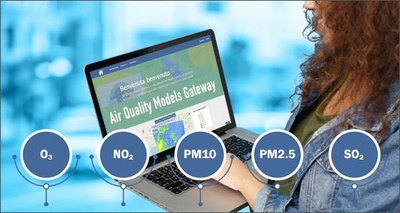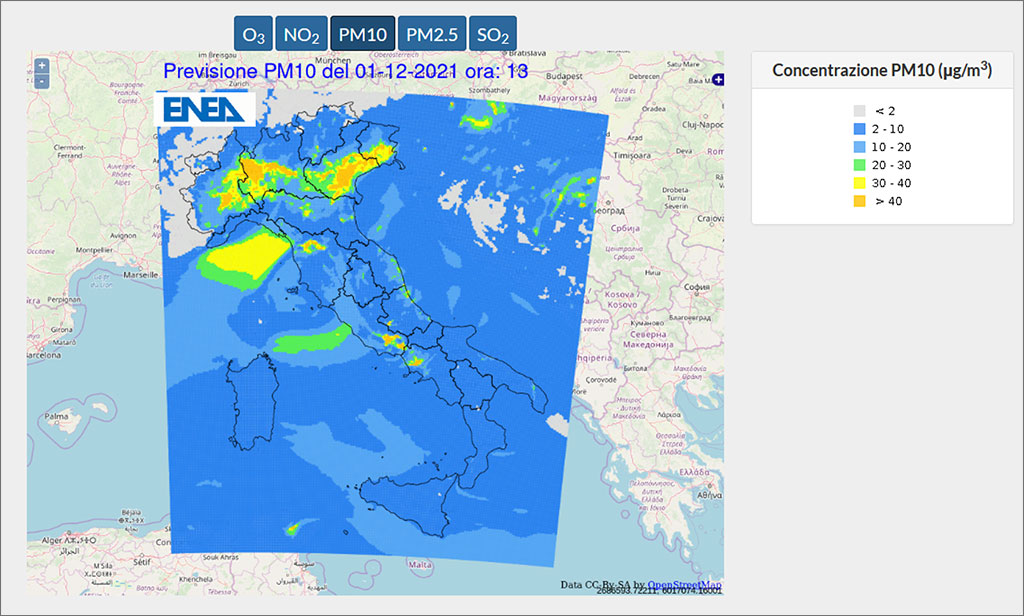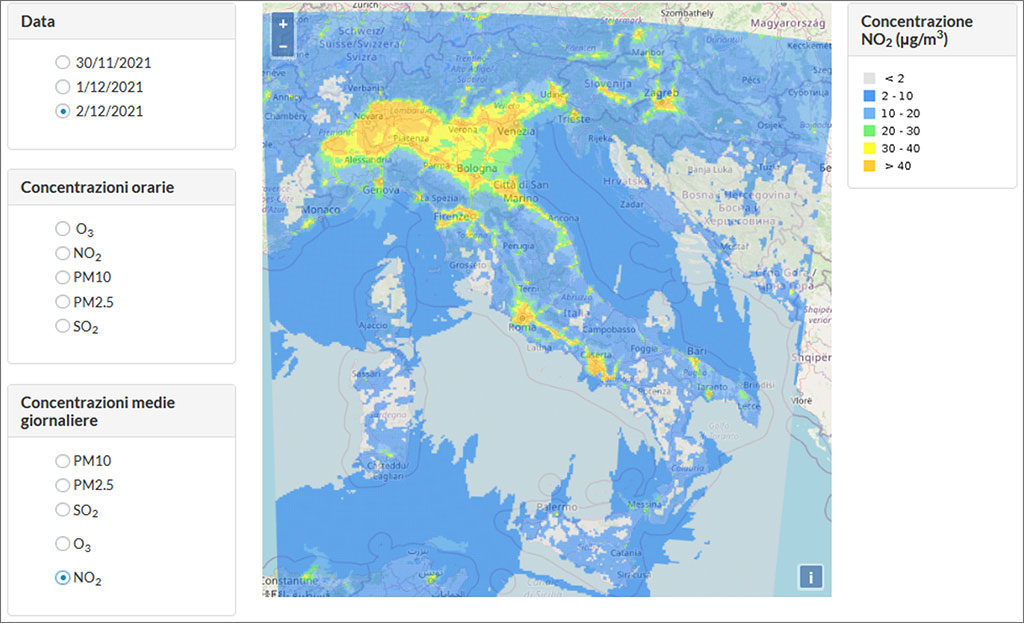Environment: ENEA launches Italy's air quality platform
23/12/2021
 'Air Quality Models Gateway' is the ENEA's platform on air quality in Italy. Developed at the "Atmospheric Pollution" and "Analysis and Protection of Critical Infrastructures" laboratories of ENEA, with the support of the Ministry of Ecological Transition as part of a collaboration agreement with ISPRA, the Higher Institute of Health and the Pollution Institute Atmospheric of the CNR, it has the aim of ensuring an effective implementation of the NEC Directive - National Emission Ceilings regarding the reduction of national emissions of some pollutants [1].
'Air Quality Models Gateway' is the ENEA's platform on air quality in Italy. Developed at the "Atmospheric Pollution" and "Analysis and Protection of Critical Infrastructures" laboratories of ENEA, with the support of the Ministry of Ecological Transition as part of a collaboration agreement with ISPRA, the Higher Institute of Health and the Pollution Institute Atmospheric of the CNR, it has the aim of ensuring an effective implementation of the NEC Directive - National Emission Ceilings regarding the reduction of national emissions of some pollutants [1].
The portal enables real-time updating and a forecast of up to three days of the concentrations of air pollutants harmful to health such as PM10, PM2.5, Ozone (O3), nitrogen dioxide (NO2) and sulfur dioxide (SO2), generated by all polluting activities (mobility, heating, industry, agriculture, but also natural emissions and Saharan sands).
“The platform we have developed is an innovation in Italy. For the first time, all citizens can have a full picture - past, present and future - of the quality of the air they breathe across the country, while researchers and sector operators will have an effective, updated and easy-to-use tool at their disposal to conduct research, planning and control of atmospheric pollution ”, explained the ENEA researchers Gaia Righini and Alberto Tofani.
In detail, the 'forecast data' section of the 'Air Quality Models Gateway' portal provides three-day air quality forecasts, with a pollutant concentrations display of hourly values and daily averages; this makes it possible to know in advance atmospheric concentrations of the pollutants monitored, which damage human health.
The section follows the "European Air Quality" web platform, developed by the Copernicus Atmosphere Monitoring Service of the European Commission. The simulations are conducted adopting the ENEA 'FORAIR-IT' forecasting modeling system which provides weather and air quality forecasts across the country, with a horizontal spatial resolution of 4 km for each hour of the following three days, thanks to the ENEA "CRESCO" supercomputer.
The 'historical data' section, on the other hand, contains simulations of air quality in Italy in 2003-2010 and 2015, conducted by "MINNI"[2] the ENEA atmospheric modeling system which provides annual and seasonal averages of pollutant concentrations, time series of points of interest and annual statutory statistics. Registered users can access all services, unregistered users a minimal demo version.
"Monitoring, systematic assessment and short-term air quality forecasts, as well as the development of medium-long term scenarios on the effects of emission reduction policies are all established activities in our country, but they require innovation and continuous updates.
Our new web platform is heading in this direction, since it provides further knowledge on air pollution in Italy and constantly updated modeling tools, which, in our context, are particularly urgent. Italy has in fact been referred to the European Court of Justice for continually exceeding the PM10 limits from 2008 to 2017 and we await the rulings regading two infringement procedures on PM2.5 and NO2”, Antonio Piersanti, head of the Atmospheric Pollution Laboratory, said.
According to the latest European Environment Agency (EEA) report, in 2019 in Europe 307,000 premature deaths were due to chronic exposure to fine particulate matter, over 40,000 to nitrogen dioxide and nearly 17,000 to ozone. In 2019, in Italy alone, PM2.5[3] caused the premature death of almost 50,000 people, a figure that puts our country in second place, after Germany, in air pollution-related deaths.


For more information please contact:
Antonio Piersanti, ENEA - Models and Technologies for the Reduction of Anthropogenic Impacts and Natural Risks Division – Head of the Atmospheric Pollution Laboratory -antonio.piersanti@enea.it
Gaia Righini, ENEA – Models and Technologies for the Reduction of Anthropogenic Impacts and Natural Risks Division- gaia.righini@enea.it
Alberto Tofani, ENEA - Analyses and Protection of Critical Infrastructures Laboratories- alberto.tofani@enea.it http://airqualitymodels.enea.it/
[1] The NEC Directive 2016/2284 establishes national limits for atmospheric emissions of specific pollutants (sulfur dioxide, nitrogen oxides, non-methane volatile organic compounds, ammonia and fine particles) for the period 2020-2029 and from 2030 onwards.
[2] MINNI (National Integrated Model for International Negotiation on Air Pollution Issues) supports the Ministry of Ecological Transition in the implementation of the European Directives on Ambient Air Quality (Legislative Decree 155/2010) and on Atmospheric pollutants (Legislative Decree 81/2018).
[3] The new 2021 WHO air quality guideline, with a PM2.5 limit of 5 µg/m3, would have reduced related premature deaths by at least 58%. The EU 27 has implemented the Zero Pollution Action Plan to reduce the number of premature deaths from exposure to fine particulate matter by 55% by 2030, compared to 2005. Based on the European Environment Agency's estimate of 456 thousand premature deaths attributable to fine particulate matter in 2005, EU measures would make it possible to reduce the number of premature deaths in Europe by 250,800.
